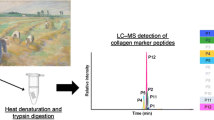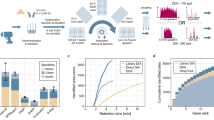Abstract
A broadband collision-induced dissociation (bbCID) fragmentation mode was proposed for liquid chromatography–mass spectrometric targeted analysis of tryptic peptides obtained from proteins in samples of decoration paint coating. In this approach, a mass spectrometric dataset contains the information on the parent and all fragment ions. This maintains a balance between the quantity of simultaneously acquired data and the sensitivity of the method, which is beneficial under coupling with analytical chromatography. In this study, characteristic peptides were selected for casein, ovalbumin, and collagen, which are the most commonly used binder proteins in the artworks. A simplified sample preparation protocol including only protein extraction and trypsinization was tested and successfully implemented. The combination of analytical chromatography with bbCID MS technique is a lower cost alternative to the use of high-end nano-LC–MS approaches in the investigation of cultural heritage objects of regional or local importance, e.g., prior to and/or during restoration works. It was demonstrated that, for the paint coating samples, the required level of sensitivity could be acquired through the data-independent MS/MS strategy. The proposed approach was tested on a sample obtained during the restoration work at the Gromov cottage in the Lopukhin Garden (middle of the XIX century). As a result, the main protein component, collagen, was identified using 6 characteristic peptides, which may indicate the use of gelatin-based glue. For instance, the identification of the peptide GVQGPPoxGPAGPR of the incoming collagen composition α-1 was undertaken by three parameters: m/z of the precursor ion of 553.2910, m/z of the fragment ion y9 of 821.4238, and retention time of 1.9 min.
Graphical abstract






Similar content being viewed by others
References
Vandenabeele P, Edwards HGM, Moens L. A decade of Raman spectroscopy in art and archeology. Chem Rev. 2007;107(3):675–86. https://doi.org/10.1021/cr068036i.
Calvano CD, Rigante E, Picca RA, Cataldi TRI, Sabbatini L. An easily transferable protocol for in-situ quasi-non-invasive analysis of protein binders in works of art. Talanta. 2020;215: 120882. https://doi.org/10.1016/j.talanta.2020.120882.
Ong SE, Mann M. Mass spectrometry–based proteomics turns quantitative. Nat Chem Biol. 2005;1(5):252–62. https://doi.org/10.1038/nchembio736.
Dubrovskii Y, Murashko E, Chuprina O, Beltyukov P, Radilov A, Solovyev N, Babakov V. Mass spectrometry based proteomic approach for the screening of butyrylcholinesterase adduct formation with organophosphates. Talanta. 2019;197:374–82. https://doi.org/10.1016/j.talanta.2019.01.059.
Steen H, Mann M. The ABC’s (and XYZ’s) of peptide sequencing. Nat Rev Mol Cell Biol. 2004;5(9):699–711. https://doi.org/10.1038/nrm1468.
Osinalde N, Aloria K, Omaetxebarria MJ, Kratchmarova I. Targeted mass spectrometry: an emerging powerful approach to unblock the bottleneck in phosphoproteomics. J Chromatogr B. 2017;1055:29–38. https://doi.org/10.1016/j.jchromb.2017.04.026.
Aebersold R, Mann M. Mass spectrometry-based proteomics. Nature. 2003;422(6928):198–207. https://doi.org/10.1038/nature01511.
Vinciguerra R, Illiano A, De Chiaro A, Carpentieri A, Lluveras-Tenorio A, Bonaduce I, Marino G, Pucci P, Amoresano A, Birolo L. Identification of proteinaceous binders in paintings: a targeted proteomic approach for cultural heritage. Microchem J. 2019;144:319–28. https://doi.org/10.1016/j.microc.2018.09.021.
Couto N, Davlyatova L, Evans CA, Wright PC. Application of the broadband collision-induced dissociation (bbCID) mass spectrometry approach for protein glycosylation and phosphorylation analysis. Rapid Commun Mass Spectrom. 2018;32(2):75–85. https://doi.org/10.1002/rcm.8016.
Welker F, Collins MJ, Thomas JA, Wadsley M, Brace S, Cappellini E, Turvey ST, Reguero M, Gelfo JN, Kramarz A, Burger J, Thomas-Oates J, Ashford DA, Ashton PD, Rowsell K, Porter DM, Kessler B, Fischer R, Baessmann C, Kaspar S, Olsen JV, Kiley P, Elliott JA, Kelstrup CD, Mullin V, Hofreiter M, Willerslev E, Hublin JJ, Orlando L, Barnes I, Macphee RDE. Ancient proteins resolve the evolutionary history of Darwin’s South American ungulates. Nature. 2015;522(7554):81–4. https://doi.org/10.1038/nature14249.
Gaspari M, Cuda G (2011) Nano LC-MS/MS: a robust setup for proteomic analysis. Methods Mol Biol 790. https://doi.org/10.1007/978-1-61779-319-6_9.
Rogers JC, Bomgarden RD (2016) Sample preparation for mass spectrometry-based proteomics; from proteomes to peptides. In. Springer International Publishing, pp 43–62. https://doi.org/10.1007/978-3-319-41448-5_3.
Ahsan N, Rao RSP, Gruppuso PA, Ramratnam B, Salomon AR. Targeted proteomics: current status and future perspectives for quantification of food allergens. J Proteomics. 2016;143:15–23. https://doi.org/10.1016/j.jprot.2016.04.018.
Hollender J, Van Bavel B, Dulio V, Farmen E, Furtmann K, Koschorreck J, Kunkel U, Krauss M, Munthe J, Schlabach M, Slobodnik J, Stroomberg G, Ternes T, Thomaidis NS, Togola A, Tornero V (2019) High resolution mass spectrometry-based non-target screening can support regulatory environmental monitoring and chemicals management. Environ Sci Europe 31 (1). https://doi.org/10.1186/s12302-019-0225-x.
Vidova V, Spacil Z. A review on mass spectrometry-based quantitative proteomics: targeted and data independent acquisition. Anal Chim Acta. 2017;964:7–23. https://doi.org/10.1016/j.aca.2017.01.059.
Cerqueira LB, Fachi MM, Kawaguchi WH, Pontes FLD, de Campos ML, Pontarolo R. New validated method for quantification of glycated hemoglobin by LC-QToF-MS: is HRMS able to quantify clinical samples? J Am Soc Mass Spectrom. 2020;31(6):1172–9. https://doi.org/10.1021/jasms.9b00049.
Jia W, Shi L, Zhang F, Chang J, Chu XG. High-throughput mass spectrometry scheme for screening and quantification of flavonoids in antioxidant nutraceuticals. J Chromatogr A. 2019;1608:12. https://doi.org/10.1016/j.chroma.2019.460408.
Shreiner EV, Murashko EA, Dubrovskii YA, Krasnov NV, Podolskaya EP, Babakov VN. Identification of rat and human hemoglobin acetylation sites formed as a result of interaction with acetylsalicylic acid. Russ J Bioorg Chem. 2012;38(2):126–32. https://doi.org/10.1134/S1068162012020094.
Sahiri T (2021) NanoPhotometer® NP80/N60/N50/C40 User Manual. https://www.implen.de/wp-content/uploads/downloads/User-Manual-V3.1.1_NP80_N60_N50_C40-17_08_22.pdf. Accessed 19 April 2021
Zhang Y, Fonslow BR, Shan B, Baek MC, Yates Iii JR. Protein analysis by shotgun/bottom-up proteomics. Chem Rev. 2013;113(4):2343–94. https://doi.org/10.1021/cr3003533.
Lenco J, Vajrychova M, Pimkova K, Proksova M, Benkova M, Klimentova J, Tambor V, Soukup O. Conventional-flow liquid chromatography-mass spectrometry for exploratory bottom-up proteomic analyses. Anal Chem. 2018;90(8):5381–9. https://doi.org/10.1021/acs.analchem.8b00525.
Macklin A, Khan S, Kislinger T (2020) Recent advances in mass spectrometry based clinical proteomics: applications to cancer research. Clin Proteomics 17 (1). https://doi.org/10.1186/s12014-020-09283-w.
Dallongeville S, Koperska M, Garnier N, Reille-Taillefert G, Rolando C, Tokarski C. Identification of animal glue species in artworks using proteomics: application to a 18th century gilt sample. Anal Chem. 2011;83(24):9431–7. https://doi.org/10.1021/ac201978j.
Vinciguerra R, De Chiaro A, Pucci P, Marino G, Birolo L. Proteomic strategies for cultural heritage: from bones to paintings. Microchem J. 2016;126:341–8. https://doi.org/10.1016/j.microc.2015.12.024.
Cong Y, Motamedchaboki K, Misal SA, Liang Y, Guise AJ, Truong T, Huguet R, Plowey ED, Zhu Y, Lopez-Ferrer D, Kelly RT. Ultrasensitive single-cell proteomics workflow identifies >1000 protein groups per mammalian cell. Chem Sci. 2021;12(3):1001–6. https://doi.org/10.1039/d0sc03636f.
Peixoto A, Ferreira D, Azevedo R, Freitas R, Fernandes E, Relvas-Santos M, Gaiteiro C, Soares J, Cotton S, Teixeira B, Paulo P, Lima L, Palmeira C, Martins G, Oliveira MJ, Silva AMN, Santos LL, Ferreira JA (2021) Glycoproteomics identifies HOMER3 as a potentially targetable biomarker triggered by hypoxia and glucose deprivation in bladder cancer. J Exp Clin Cancer Res 40 (1). https://doi.org/10.1186/s13046-021-01988-6.
Leo G, Cartechini L, Pucci P, Sgamellotti A, Marino G, Birolo L. Proteomic strategies for the identification of proteinaceous binders in paintings. Anal Bioanal Chem. 2009;395(7):2269–80. https://doi.org/10.1007/s00216-009-3185-y.
Holt C, Carver JA, Ecroyd H, Thorn DC. Invited review: caseins and the casein micelle: their biological functions, structures, and behavior in foods. J Dairy Sci. 2013;96(10):6127–46. https://doi.org/10.3168/jds.2013-6831.
van Huizen NA, Ijzermans JNM, Burgers PC, Luider TM. Collagen analysis with mass spectrometry. Mass Spectrom Rev. 2020;39(4):309–35.
Liebler DC, Zimmerman LJ. Targeted quantitation of proteins by mass spectrometry. Biochemistry. 2013;52(22):3797–806. https://doi.org/10.1021/bi400110b.
Müller T, Winter D. Systematic evaluation of protein reduction and alkylation reveals massive unspecific side effects by iodine-containing reagents. Mol Cell Proteomics. 2017;16(7):1173–87. https://doi.org/10.1074/mcp.m116.064048.
Tomascova A, Lehotsky J, Kalenska D, Baranovicova E, Kaplan P, Tatarkova Z. A comparison of albumin removal procedures for proteomic analysis of blood plasma. Gen Physiol Biophys. 2019;38(4):305–14. https://doi.org/10.4149/gpb_2019009.
Tsang JS, Friedberg E, Lam T. An easy-to-use method for preparing paint cross sections. J Am Inst Conserv. 2019;58(3):123–31. https://doi.org/10.1080/01971360.2018.1564198.
Sandu ICA, Schäfer S, Magrini D, Bracci S, Roque CA. Cross-section and staining-based techniques for investigating organic materials in painted and polychrome works of art: a review. Microsc Microanal. 2012;18(4):860–75. https://doi.org/10.1017/s1431927612000554.
Henrik-Klemens Å, Bengtsson F, Björdal CG (2021) Raman spectroscopic investigation of iron-tannin precipitates in waterlogged archaeological oak. Stud Conserv:1–11. https://doi.org/10.1080/00393630.2020.1864895.
Conti C, Botteon A, Colombo C, Pinna D, Realini M, Matousek P. Advances in Raman spectroscopy for the non-destructive subsurface analysis of artworks: Micro-SORS. J Cult Herit. 2020;43:319–28. https://doi.org/10.1016/j.culher.2019.12.003.
Dallongeville S, Richter M, Schafer S, Kuhlenthal M, Garnier N, Rolando C, Tokarski C. Proteomics applied to the authentication of fish glue: application to a 17th century artwork sample. Analyst. 2013;138(18):5357–64. https://doi.org/10.1039/c3an00786c.
Leo G, Bonaduce I, Andreotti A, Marino G, Pucci P, Colombini MP, Birolo L. Deamidation at asparagine and glutamine as a major modification upon deterioration/aging of proteinaceous binders in mural paintings. Anal Chem. 2011;83(6):2056–64. https://doi.org/10.1021/ac1027275.
Solazzo C, Clerens S, Plowman JE, Wilson J, Peacock EE, Dyer JM. Application of redox proteomics to the study of oxidative degradation products in archaeological wool. J Cult Herit. 2015;16(6):896–903. https://doi.org/10.1016/j.culher.2015.02.006.
Acknowledgements
The authors thank Research Institute of Hygiene, Occupational Pathology and Human Ecology, Federal Medical Biological Agency (St. Petersburg, Russia) for providing human blood sample for hemoglobin isolation.
Funding
The study was supported by the grant of the Russian Science Foundation, grant No. 19-73-00135.
Author information
Authors and Affiliations
Corresponding author
Ethics declarations
Ethics
Human blood sample used in the current study was provided by the Research Institute of Hygiene, Occupational Pathology and Human Ecology, Federal Medical Biological Agency (St. Petersburg, Russia). A healthy volunteer provided informed consent prior to blood sampling. The sampling was approved by the local Bioethics Committee of the Research Institute of Hygiene, Occupational Pathology and Human Ecology, Federal Medical Biological Agency (St. Petersburg, Russia); approval protocol No. 3 dated 15 March 2018.
Conflict of interest
The authors declare no competing interests.
Additional information
Publisher's note
Springer Nature remains neutral with regard to jurisdictional claims in published maps and institutional affiliations.
Supplementary Information
Below is the link to the electronic supplementary material.
Rights and permissions
About this article
Cite this article
Dubrovskii, Y., Krivul’ko, T., Gavrilenko, L. et al. Targeted proteomics for the analysis of cultural heritage: application of broadband collision-induced dissociation mass spectrometry. Anal Bioanal Chem 414, 1723–1737 (2022). https://doi.org/10.1007/s00216-021-03805-7
Received:
Revised:
Accepted:
Published:
Issue Date:
DOI: https://doi.org/10.1007/s00216-021-03805-7




